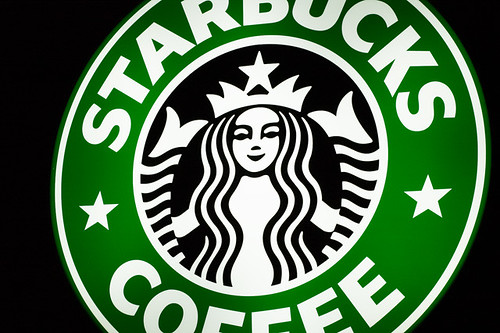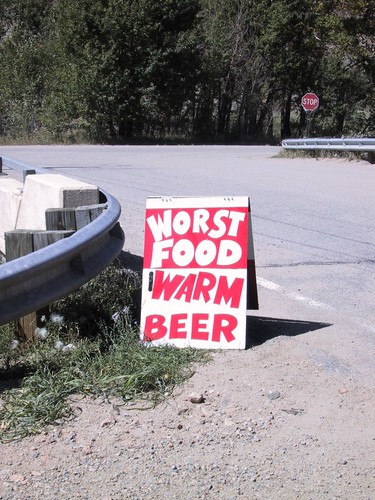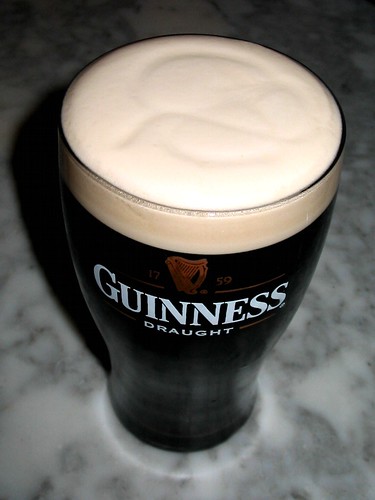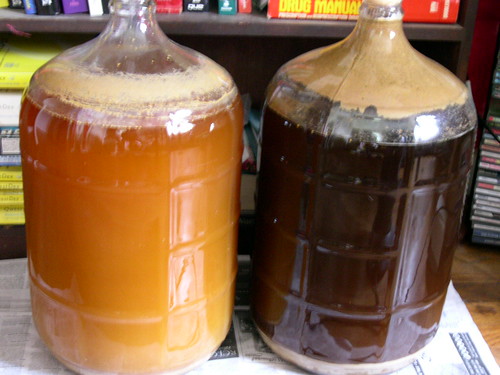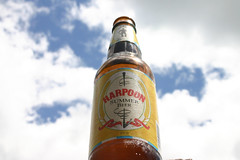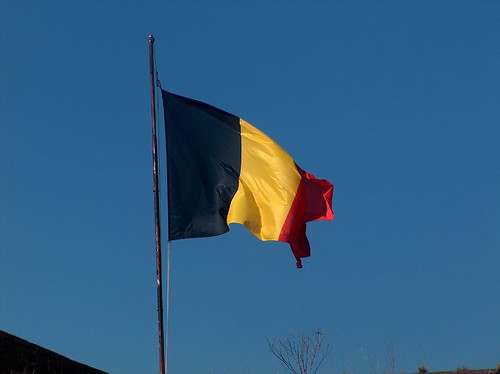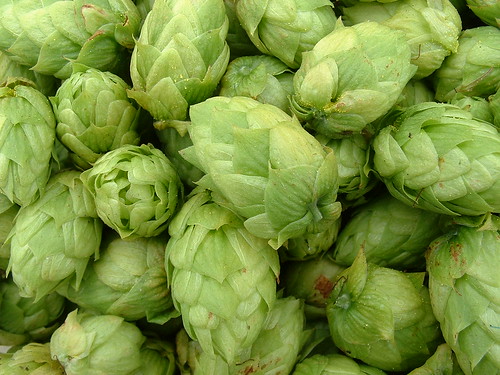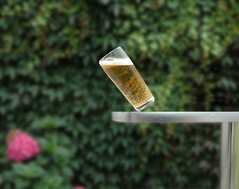 Lately our posts have portrayed us as globetrotting adventurers, largely ignoring our own backyard. Together Mike and I have taken you to the DMZ for North Korean beer, the brewpubs of South Korea, the only brewery in the Islamic Republic of Pakistan, and beautiful Seattle in the Pacific Northwest. This surely isn't the end of our wanderlust; it knows no bounds and we will continue to hunt down tasty beer anywhere it might hide. But honestly, sometimes you just get homesick. That's why this week we decided to explore one of our favorite watering holes across the river in Cambridge, the Cambridge Brewing Company. Public transit in Boston doesn't exactly make it easy to get to this gem from my home in Brighton, so we aren't exactly regulars there, but we are familiar enough, and the journey was worth it.
Lately our posts have portrayed us as globetrotting adventurers, largely ignoring our own backyard. Together Mike and I have taken you to the DMZ for North Korean beer, the brewpubs of South Korea, the only brewery in the Islamic Republic of Pakistan, and beautiful Seattle in the Pacific Northwest. This surely isn't the end of our wanderlust; it knows no bounds and we will continue to hunt down tasty beer anywhere it might hide. But honestly, sometimes you just get homesick. That's why this week we decided to explore one of our favorite watering holes across the river in Cambridge, the Cambridge Brewing Company. Public transit in Boston doesn't exactly make it easy to get to this gem from my home in Brighton, so we aren't exactly regulars there, but we are familiar enough, and the journey was worth it.Inspired by my own recent article on Cask Ale, I decided to try my luck. I say try my luck because everytime I order a Cask Ale at the CBC, the cask seems to have mysteriously "just kicked." This time I lucked out, they had an ESB with Columbus hops. The first thing I noticed was the sparkler tip on the spout, and the fact that a second beer engine next to it had none. You see sparkler tips are added to the end of the spout to agitate the beer on the way out. This strips some of the CO2 out of solution, giving you a nice creamy head. I believe this was actually the first time I ever had a cask ale with a sparkler tip, and the head held up much better than I was led to believe it would. It probably also contributed to a delightfully creamy mouthfeel. But what's most important is that the beer engine next to it had no sparkler tip.
 Sparklers are a bit of a touchy subject among cask beer aficionados. They do give a creamy head and improve on the presentation of the beer, but they also strip some of the delicate hop compounds and a good bit of bitterness out of the beer itself and deposit it in the head. This can throw off the balance of the beer (not only by removing hop bitterness, but also by removing dissolved CO2, which lowers the acidity of the beer). It also sort of mutes the hop character a bit. Neither of these is necessarily a problem though, as long as the recipe was formulated with these effects in mind. If a beer was meant to be served with a sparkler and is served without it, it may be too harsh. If it was meant to be served without it and the establishment ignores the brewer's recommendations in the name of showmanship, then the character will suffer and the beer will be milder than it should be. The fact that they have one of each at the CBC tells me that they have kept this debate in mind and are consciously considering these issues when formulating recipes and serving their cask beers, and that is a very encouraging sign. I don't have much experience with the ESB style, but the level of harshness and hoppiness was about what I would have expected - the hops were clearly present in the nose and flavor but not overly assertive, sort of punctuating a more assertive, slightly toasty, nutty malt. The serving temperature was also appropriate, so I'm going to add CBC to the list of Punk-approved Casks in the Boston Metro area. Mike, who's not as into casks as I am, agreed with me that this had earned at least a four out of five.
Sparklers are a bit of a touchy subject among cask beer aficionados. They do give a creamy head and improve on the presentation of the beer, but they also strip some of the delicate hop compounds and a good bit of bitterness out of the beer itself and deposit it in the head. This can throw off the balance of the beer (not only by removing hop bitterness, but also by removing dissolved CO2, which lowers the acidity of the beer). It also sort of mutes the hop character a bit. Neither of these is necessarily a problem though, as long as the recipe was formulated with these effects in mind. If a beer was meant to be served with a sparkler and is served without it, it may be too harsh. If it was meant to be served without it and the establishment ignores the brewer's recommendations in the name of showmanship, then the character will suffer and the beer will be milder than it should be. The fact that they have one of each at the CBC tells me that they have kept this debate in mind and are consciously considering these issues when formulating recipes and serving their cask beers, and that is a very encouraging sign. I don't have much experience with the ESB style, but the level of harshness and hoppiness was about what I would have expected - the hops were clearly present in the nose and flavor but not overly assertive, sort of punctuating a more assertive, slightly toasty, nutty malt. The serving temperature was also appropriate, so I'm going to add CBC to the list of Punk-approved Casks in the Boston Metro area. Mike, who's not as into casks as I am, agreed with me that this had earned at least a four out of five.I was certainly glad that I went straight for the cask as well, because Mike and I soon discovered why they're always out. Apparently the CBC taps their cask Tuesdays at 5PM and they are kicked within hours. The reason? Even though it is being served from a barrel-sized vessel (about 31 gallons) there's only about 5-7 gallons in the cask when it is tapped. I was shocked at this, since that's the same volume most homebrewers work with, I expected far more from a brewpub as popular as CBC.
Most likely they are trying to have a quick turnover because, as I'll discuss in more detail in a later post, casks are living beasts and need to be finished quickly before wild yeast infections and oxidation take too much of a toll. But personally, I would advocate that they either start tapping more than one cask a week, or fill the casks a bit more.
I've heard (though I can't really confirm or deny it) that a properly stored cask is still usable for up to three days, and in fact the aging of the beer over that time period can actually be viewed as a positive thing, adding complexity. Go much past that and it goes downhill fast, but in the beginning the changes are slow and sometimes welcome. At any rate, CBC has made the list of approved Casks, and you should try to make it out there if you are in the area on a Tuesday. Just don't dawdle!
 Once Mike and I had kicked the cask (literally...we managed to snag the last pint) it was time to move on. Now the beer menu at CBC includes four house brews that tend to be pretty safe (if somewhat boring) beers styles: the Regatta Golden Kolsch, the Tall Tale Pale Ale, the Cambridge Amber Ale, and the Charles River Porter. Usually, Mike and I skip over these and go straight to the seasonals, looking for the biggest, Belgianiest thing we can find. But this time we decided to try the whole lineup for once. We got tasters of the four house brews, as well as two of the lighter options on the seasonal menu, the HalfWit belgian wheat and the Hefeweizen. It should be stated that I'm not a fan of tasting things from taster size glasses. For one thing, it's tough to get a good nose off of such a small sample, filled to the brim because there's nowhere for the aromas to collect themselves at the top of the glass. But we had alot to accomplish here, and both of us had to work the next day.
Once Mike and I had kicked the cask (literally...we managed to snag the last pint) it was time to move on. Now the beer menu at CBC includes four house brews that tend to be pretty safe (if somewhat boring) beers styles: the Regatta Golden Kolsch, the Tall Tale Pale Ale, the Cambridge Amber Ale, and the Charles River Porter. Usually, Mike and I skip over these and go straight to the seasonals, looking for the biggest, Belgianiest thing we can find. But this time we decided to try the whole lineup for once. We got tasters of the four house brews, as well as two of the lighter options on the seasonal menu, the HalfWit belgian wheat and the Hefeweizen. It should be stated that I'm not a fan of tasting things from taster size glasses. For one thing, it's tough to get a good nose off of such a small sample, filled to the brim because there's nowhere for the aromas to collect themselves at the top of the glass. But we had alot to accomplish here, and both of us had to work the next day.We found the four house brews were nearly all over-hopped for our taste. None were outrageously over-hopped, and many craft beer drinkers would likely disagree with us on this one. If you really like hops, you can't really go wrong with any of the house brews. For Mike and I though, this kept most of them down to only a three out of five. The beers also shared a bit of creaminess in the mouthfeel which was very welcome.
The Regatta Golden Kolsch was the exception, which displayed an appropriate level of malt and no really significant hop presence, just a delightful citrusy flavor that could have come from either a light application of hops or yeast effects.
We both felt that the Pale would make a much better IPA than a Pale Ale. It wasn't that it was a bad beer, but the hoppiness seemed a bit much for us to consider it a Pale, but I suppose that's fashionable. One thing I noted, however, was that drinking the dregs of the Pale Ale taster after it had warmed was a bit more pleasant. There was some nice notes of butterscotch that came out as it warmed up, and I suspect this one would make a fantastic cask ale.
We also found the coffee notes in the Porter to be a bit too assertive, as was the hops in the aftertaste. But again, this is highly palate dependent.
The most interesting of the house brews, however, was the Cambridge Amber. Again it seemed over-hopped for an amber, but the malt complexity helped balance this and make it a very fine beer indeed. I picked up a hint of smokiness that I really latched onto and Mike and I both got welcome notes of peach, probably yeast derived. This was the only beer from the main lineup that earned a four out of five.
The Hefeweizen was interesting too, in that it seemed to suffer the opposite affliction of most American brewed hefeweizens. Usually American brewers tend to eschew the more phenolic yeasts used by the Germans in favor of estery american ale yeasts. The result is fruity, often overly citrusy, and wholly unpleasant to me. It seems CBC took the opposite extreme here with the phenolic notes being a bit too assertive for me. I gave it a three, but it might have warmed on me had I had longer with it.
The Half Wit was one of the drier Belgian White Ales I've had, but I think that's appropriate to the style. The citrus orange flavor was a bit more mild than I'm used to as well. It had the expected coriander notes and a balanced flavor. It also went down quite smooth. Personally I had to give it a three because the dryness was too much for me, but Mike liked this one alot, and gave it a four.
After the dainty tasters it was time for what we love best: the big, the bold, and the Belgian. CBC really shines when it comes to the big, unique beers that Mike and I enjoy, employing lots of wood aging, Brettanomyces yeast, bacterial cultures, and anything else they can find to make the best beer possible. The higher alcohol beers on their seasonal menu are what keeps us coming back; they might not be for everyone but often seem tailor-made to our malt-and-yeast starved palates. Also, don't let the fact that they refer to them as "seasonals" fool you. This portion of the menu is ever changing and if you find something you like, you need to take advantage of it as much as possible. Mike still feels the sting he experienced when hearing months ago that they had run out of the Kendall Weiss Berlinerweiss (codenamed "the Woodruff" by the Punks). Be forewarned, the best beers here will not stay around long and are often unavailable in growlers, so come early and often while you can.
Mike started off with the Cerise Cassee, a sour wild ale with cherries fermented slowly by a cocktail of wild yeast strains and bacterial cultures in French oak wine barrels. It was pretty aggressively sour, exhibiting some character that I've seen in CBC's specialty beers before, reminding me a bit of sweet pickle juice. I'm a fan of pickle juice mind you, but not generally in my beer. The balance was a bit too sour for me and I probably wouldn't order it again, but Mike really enjoyed the aftertaste, which reminded him of sour cherries, and it went down kind of crisp and refreshing due to all of the acidity. I gave it a two, Mike was more pleased and gave it a three. With a bit more sweetness in the balance I would have been more generous. One thing we could agree on, this one is not a session beer, but worth a try if you're into funk.
The importance of balance was reflected in our more generous scores for the other two new specialty beers we tried. Both "YouEnjoyMyStout" and Arquebus had a detectable level of that same pickle juice tang in them, but both garnered four out five from at least one of us.
 The Arquebus was referred to as a summer barleywine. Intrigued, I asked what that meant. The more familiar winter barleywine from CBC, Blunderbuss (which we've consistently placed somewhere between a three and a four) is a more typical barleywine: heavy, sweet balance, extraordinarily complex yeast and malt character, and very light on hops. The Arquebus includes honey and white wine grapes into the typical malt bill for a lighter, dryer character that is more seasonally appropriate. It also uses a bit more hops for slightly more bitter balance. Mike likened it to his much beloved mead (honey wine) that we often taste at the Sunset, but carbonated. I agreed - more specifically the flavor reminded me of a few samples of braggot I've tried (this would be mead with malt included along with the honey). There was a hint of tang to it as I said, but this was well balanced by the sweetness and hops. The nose was a bit harder for me to like, since there wasn't as much hop and the sourness was thus much more assertive. On flavor alone I would have agreed with Mike that this was a four, but the nose was a little off-putting and I gave it a three.
The Arquebus was referred to as a summer barleywine. Intrigued, I asked what that meant. The more familiar winter barleywine from CBC, Blunderbuss (which we've consistently placed somewhere between a three and a four) is a more typical barleywine: heavy, sweet balance, extraordinarily complex yeast and malt character, and very light on hops. The Arquebus includes honey and white wine grapes into the typical malt bill for a lighter, dryer character that is more seasonally appropriate. It also uses a bit more hops for slightly more bitter balance. Mike likened it to his much beloved mead (honey wine) that we often taste at the Sunset, but carbonated. I agreed - more specifically the flavor reminded me of a few samples of braggot I've tried (this would be mead with malt included along with the honey). There was a hint of tang to it as I said, but this was well balanced by the sweetness and hops. The nose was a bit harder for me to like, since there wasn't as much hop and the sourness was thus much more assertive. On flavor alone I would have agreed with Mike that this was a four, but the nose was a little off-putting and I gave it a three.YouEnjoyMyStout (the long name of which makes it a nice sobriety check for the bartender near last call, for sure) was a barrel aged imperial stout. Looking back at our notes, we had an opportunity to taste an aged YEMS sometime around the 20th anniversary of CBC earlier this year. We weren't that impressed; we found the wood character was a little overwhelming. So we were a little skeptical about this one, but CBC pulled through. The wood character was much milder (probably due to the shorter aging period? I don't know if they rack this one out of the barrels at some point) and offered a delightful, delicate coconut aftertaste that lingered well after the initial burst of chocolate had dropped off. The flavor had notes of that same sour pickly tang, but was well balanced by the roasty malt complexity. Comparing this to other Russian Imperial Stouts we've had, it was a totally different animal; tangy and far less hoppy, with a much lighter body (possibly due to their typical wild yeast treatments? their description doesn't describe the fermentation of this one in any detail). We gave the 2007 vintage a two, but in retrospect I feel this was unjust. We were comparing it against a baseline we were quite familiar with - the RIS style - when we should have been tasting it as more of a Belgian specialty. This younger version was fantastic, garnering a solid four out of five.
Finally, Mike and I finished the evening by returning to an old friend: the Benevolence. Benevolence has been available at the CBC for some time now; it's a truly unique beer, roughly based around Belgian lambic and Flanders sour ale brewing methods, coupled with lots of fruit and honey additions, aging in used bourbon casks. The CBC website does a far more thorough description than I could, so I won't bother with the plagiarism. Just know this one's a doozy. Last time we did a tasting, the Benevolence earned a five out of five, with Mike likening it to Port (I, the uncultured slob, having no idea what port tastes like, said it was chocolatey and fruity). This time the chocolate notes overtook all else, with Mike likening it to a chocolate martini. Then I picked up some plum, dark cherry, and other fruit notes. Then Mike caught some chocolate covered cherries and rum. Really not sure how to put this one, except to say that this is a phenominally complex beer that will offer up something different on every sip. Still very worthy of a five out of five.
Heaven forbid someone in your party is not a beer lover, the CBC also carries wine from Sutton Cellars of Sonoma, CA, who share their same penchant for wild fermentations. I tried some on a previous visit, I won't do them the injustice of trying to give tasting notes on it, but it was a very interesting wine that even I could enjoy. This is, I understand, a rarity in the wine world, as vintners do not generally share the brewers' penchant for such things as Brettanomyces and bacterial cultures.
 As for food, we were underwhelmed by the nachos (they could learn a thing or two from the Sunset Grill and Tap on that one) but the pizzas are fantastic. Specifically we had the one with Italian salami and Banana Peppers. We've also had a mean Chicken Mole at the CBC on a previous visit, but it wasn't on the menu this time. From what we've seen coming from the kitchen, some of their bar snacks are lacking, but the pizzas and entrees appear to be a good bet.
As for food, we were underwhelmed by the nachos (they could learn a thing or two from the Sunset Grill and Tap on that one) but the pizzas are fantastic. Specifically we had the one with Italian salami and Banana Peppers. We've also had a mean Chicken Mole at the CBC on a previous visit, but it wasn't on the menu this time. From what we've seen coming from the kitchen, some of their bar snacks are lacking, but the pizzas and entrees appear to be a good bet.In summation, with their beer menu split between the simple and the sublime, and some interesting beer alternatives like wild fermented wines, as well as a respectable food menu and very sociable, open atmosphere, CBC is a great option for diverse groups in the Kendall/Central square areas of Cambridge. I'd go so far as to say it's the best option for excellent beer in Cambridge/Somerville, if not for the fact that I crave variety more than anything and CBC only serves it's own beer. It does sit shoulder to shoulder with Bukowski's for this honor, however.








